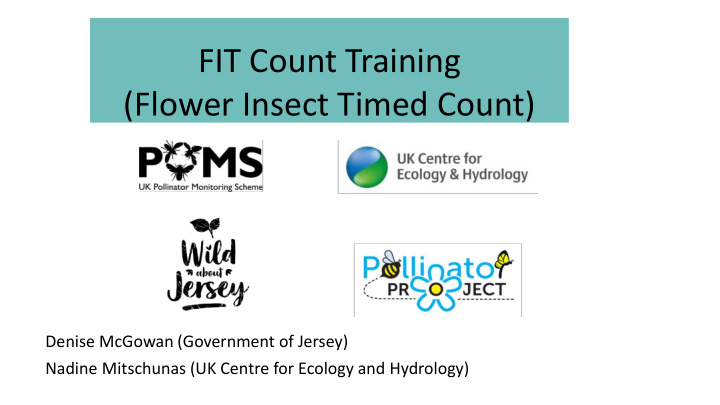



FIT Count Training (Flower Insect Timed Count) Denise McGowan (Government of Jersey) Nadine Mitschunas (UK Centre for Ecology and Hydrology)
FIT Count - Flower Insect Timed Count • With reports of dramatic losses of insects occurring across the globe, there has never been a more important time to document evidence of change in populations of pollinating insects. • Aims to establish how insect pollinator populations are changing across British Isles. • This simple survey collects data on the total number of insects that visit a particular flower.
FIT Count How to Survey • If sky is clear (less than half cloud) the minimum temperature for a count is 13°C Min 13°C • If sky is cloudy (half cloud or more) the minimum temperature for a count is 15°C • YouTube Video PoMS: Flower-Insect Timed Min 15°C Count (FIT count) • You Tube Video PoMS: Getting familiar with the Flower-Insect Timed Count (FIT Count) insect April - September groups • If you can carry out several counts at one location during that time you will be adding extra value to your survey records
FIT Count How to Survey (continued) • Choose suitable area, park, garden, area set aside for wildlife etc. - Permission - Safe to survey • Count insects that lands or crawls on flower head (Crawls eg ant, bettle etc.) • Do Not take photos during the 10 minute survey as this could disturb the insects and affect the count result. • Take photo of the plant species
50cm FIT Count How to Survey continued 50cm
FIT Count Target flowers • Flowers ideally chosen from list of 14 target species below • Dandelion • Buttercup • White Dead-nettle • Hawthorn • Bramble/Blackberry • Lavender (English) • Common/Greater Knapweed • Heather (Calluna or Erica) • Hogweed • White Clover • Ragwort • Thistle (Carduus or Cirsium) • Buddleja • Ivy
FIT Count Insect Groups Just need to identify insect to their group level, NOT species level – phew! Insect Groups – 10 different groups • Bumblebees • Honeybees • Solitary bees • Wasps (including ichneumon wasps) • Hoverflies (including ‘ nontypical ’ hoverflies) • Other flies • Butterflies and moths • Beetles (larger than 3mm) • Small insects (less than 3mm long) • Other insects Photo credits: Tim Ransom
FIT Count The form - Paper Two Pages Easy to complete Mentions target flowers
FIT Count The form - Online • Very similar to the paper form therefore easy to complete. • Email address – same as iRecord or Jersey Biodiversity Centre login • Ask you if you enjoyed it!
FIT Count What you need to do • (Create account with JBC or iRecord) • Make your 50cm 2 quadrat • Print out form or contact me d.mcgowan@gov.je or wildaboutjersey@gov.je for forms • Find your target flower • Enjoy sitting and surveying! Photo credits: Tim Ransom
FIT Count Resources • PoMS and search FIT Count • Gov.je search FIT Count • www.pollinatorproject.gg • You Tube videos • Facebook Group – “Insects of the Channel Islands” • Jersey Biodiversity Centre www.jerseybiodiversitycentre.org.je Photo credits: Tim Ransom
Thank you JBC and Sarah for Hosting! Thank you Pollinator Monitoring Scheme (PoMS) and Pollinator Project for sharing resources. Thank you for listening! Any Questions? Photo credit: Richard Perchard
Recommend
More recommend